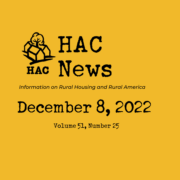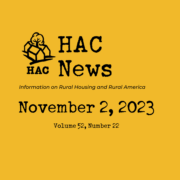Discussion Paper, Outreach and TA
OUTREACH AND TECHNICAL ASSISTANCE DELIVERY TO RURAL AND TRIBAL COMMUNITIES
 Continue the Discussionby Stan Keasling, Rural Community Assistance Corporation, CA, and Blair Sebastian, New York State Rural Housing Coalition
Continue the Discussionby Stan Keasling, Rural Community Assistance Corporation, CA, and Blair Sebastian, New York State Rural Housing Coalition
Background
Nonprofits, local governments, and tribal governments are working individually and collectively to improve the quality of housing and community infrastructure in rural areas. The technical assistance (TA) needs of rural groups vary widely and often require very different approaches. Rural communities’ TA needs may also differ substantially from the TA needs found in more urbanized places. What are the needs, and where are opportunities and methods, or approaches, to improve the outreach to these entities and the effectiveness of TA delivery in rural America?
Issues, Challenges, and Opportunities
Over the past few years there have been significant changes to the resources available for the rural technical assistance delivery system. HUD has introduced the Community Compass (formerly OneCPD) system of technical assistance, and Congress has required new competitions for Rural Capacity Building and NAHASDA TA funding. In addition, USDA is still considering the utility of the intermediaries in the Section 502 packaging demonstration, and planning for a community facilities support system. These changes have meant that the intermediaries and other TA providers are often trying to suggest new strategies to the funding agencies in order to enhance their competitiveness, rather than pursuing outreach and TA practices that have been successful in the past.
While some federal initiatives have focused on providing technical assistance to rural and tribal communities, the approach has not been well synchronized. Rural and tribal communities generally must find and request TA themselves. Much of the available TA is provided through programs that are ‘siloed’, not coordinated. In addition – aside from the former Rural Housing and Economic Development and Rural Innovation Fund, Rural Capacity Building TA, and NAHASDA TA – HUD-funded TA is most often delivered to formula grantees. Assistance from USDA is also requested through specific programs such as Self-Help Technical and Management Assistance, and not all USDA programs have a TA component.
Given the vast number of rural and tribal entities and the lack of direct federal department/agency contact with many smaller communities, mechanisms are needed to allow them to identify and secure technical resources in the most appropriate manner for them. TA providers are interested in prioritizing the greatest needs of rural and tribal communities and identifying the best methods of delivering that assistance to ensure that the array of federal technical resources are directly available to the local jurisdictions, organizations, businesses, and families.
Discussion Questions
- What technical assistance services do rural housing and community development organizations need to be more productive?
- What are the best ways to inform local rural organizations about available TA?
- What are the challenges facing local and tribal governments in trying to manage federal funds and design effective strategies for community development?
- What support do the state grantees, including PJs, need to be more effective at administering federal pass through funds and coordinating with federal agencies to maximize impact?
- What processes should be used to identify needs at the local level in rural America?
- Are there changes federal departments/agencies should consider making to their system of identifying TA needs and allocating resources to local rural and tribal efforts?


